Exposure Indices of Extreme Wind-Driven Rain Events for Built Heritage
Abstract
:1. Introduction
2. Results
2.1. Regional Case Study: Plymouth
2.2. A Demonstrative Example
2.3. Temporal Characteristics of the Time-Binned Events
2.3.1. Intensity, Duration, and Maxima
2.3.2. Consistency
2.3.3. Seasonal Characteristics
2.4. Intensity of Extreme Events
2.4.1. GEV Fitting
2.4.2. Extreme Event Index (EEI)
2.4.3. Extreme Event Maximum Index (EEMI)
2.5. Threshold Assessment
3. Discussion
3.1. Indices
3.1.1. Empirical Approaches to Wind-Driven Rain
3.1.2. Urban Complexity
3.2. Seasonality
3.3. Threshold Assessment
3.4. Direct Exposure Assessment
3.5. Future Work and Outcomes
4. Materials and Methods
4.1. Summary of Index Calculation Procedure
- Determination of wind-driven rain exposure (herein semi-empirical).
- Time-binning procedure.
- Index selection.
- Extreme value analysis.
- Impact assessment.
4.2. Determination of Wind-Driven Rain Exposure
4.3. Time-Binning
4.3.1. Existing Rules for Prolonged Exposure
4.3.2. Proposed Rules for Extreme Events
- The long event is deemed to be continuous if the aggregate of any breaks is not more than 10% of the whole.
- No single break is to be more than 5% of the time.
- The total duration is defined as the time from the beginning to the end of the event, including the dry breaks.
4.4. Index Selection
4.4.1. Extreme Event Index (EEI)
4.4.2. Extreme Event Maximum Index (EEMI)
4.5. Extreme Value Analysis
4.6. Impact Assessment
Author Contributions
Funding
Acknowledgments
Conflicts of Interest
References
- Cassar, M.; Hawkings, C. Engineering Historic Futures Stakeholders Dissemination and Scientific Research Report. 2007. Available online: https://discovery.ucl.ac.uk/id/eprint/2612/1/2612.pdf (accessed on 2 January 2020).
- BSI. BS 8104:1992—Code of Practice for Assessing Exposure of Walls To Wind-Driven Rain; Standard, British Standards Institution: London, UK, 1992. [Google Scholar]
- ISO. BS en ISO 15927-3: 2009: Hygrothermal Performance of Buildings— Calculation and Presentation of Climatic Data—Part 3: Calculation of A Driving Rain Index for Vertical Surfaces From Hourly Wind and Rain Data; Standard, International Standards Organisation: London, UK, 2009. [Google Scholar]
- Kinnison, R.R. Applied Extreme Value Statistics; Battelle Press: Columbus, OH, USA, 1985. [Google Scholar]
- Pérez-Bella, J.M.; Domínguez-Hernández, J.; Rodríguez-Soria, B.; del Coz-Díaz, J.J.; Cano-Suñén, E. Combined use of wind-driven rain and wind pressure to define water penetration risk into building façades: The Spanish case. Build. Environ. 2013, 64, 46–56. [Google Scholar] [CrossRef]
- Sabbioni, C.; Brimblecombe, P.; Cassar, M. The Atlas of Climate Change Impact on European Cultural Heritage: Scientific Analysis and Management Strategies; Anthem Press: London, UK, 19 Number 2010. [Google Scholar]
- Winkler, E.M. Important agents of weathering for building and monumental stone. Eng. Geol. 1966, 1, 381–400. [Google Scholar] [CrossRef]
- Stephenson, V.; D’Ayala, D. Structural Response of Masonry Infilled Timber Frames to Flood and Wind Driven Rain Exposure. J. Perform. Constr. Facil. 2019, 33, 04019028. [Google Scholar] [CrossRef]
- D’Ayala, D.; Aktas, Y.D. Moisture dynamics in the masonry fabric of historic buildings subjected to wind-driven rain and flooding. Build. Environ. 2016, 104, 208–220. [Google Scholar] [CrossRef] [Green Version]
- UK Met Office. MIDAS: UK Hourly Weather Observation Data; UK Met Office: Exeter, UK, 2006. [Google Scholar]
- UK Met Office. MIDAS: UK Hourly Rainfall Data; UK Met Office: Exeter, UK, 2006. [Google Scholar]
- Gould, J. Architecture and the plan for Plymouth: The legacy of a British city. Archit. Rev. 2007, 221, 78–83. [Google Scholar]
- Strong Winds: Woman Killed and Ferry Travel Disrupted. BBC News. 2 November 2019. Available online: https://www.bbc.co.uk/news/uk-england-50273590 (accessed on 7 November 2019).
- Orr, S.A.; Viles, H. Characterisation of building exposure to wind-driven rain in the UK and evaluation of current standards. J. Wind Eng. Ind. Aerodyn. 2018, 180, 88–97. [Google Scholar] [CrossRef]
- Orr, S.A.; Young, M.; Stelfox, D.; Curran, J.; Viles, H. Wind-driven rain and future risk to built heritage in the United Kingdom: Novel metrics for characterising rain spells. Sci. Total Environ. 2018, 640, 1098–1111. [Google Scholar] [CrossRef] [PubMed]
- Blocken, B.; Carmeliet, J. A review of wind-driven rain research in building science. J. Wind Eng. Ind. Aerodyn. 2004, 92, 1079–1130. [Google Scholar] [CrossRef]
- Chan, S.; Kendon, E.; Roberts, N.; Fowler, H.; Blenkinsop, S. The characteristics of summer sub-hourly rainfall over the southern UK in a high-resolution convective permitting model. Environ. Res. Lett. 2016, 11, 094024. [Google Scholar] [CrossRef]
- Hansen, T.K.; Bjarløv, S.P.; Peuhkuri, R. The effects of wind-driven rain on the hygrothermal conditions behind wooden beam ends and at the interfaces between internal insulation and existing solid masonry. Energy Build. 2019, 196, 255–268. [Google Scholar] [CrossRef]
- Historic England. Maintenance Plans for Older Buildings. Available online: https://historicengland.org.uk/advice/technical-advice/buildings/maintenance-plans-for-older-buildings/ (accessed on 12 December 2019).
- Guttman, N. Guide to Climatological Practices; Technical Report 100; World Meteorological Organisation: Geneva, Switzerland, 2011. [Google Scholar]
- Blocken, B.; Carmeliet, J. On the validity of the cosine projection in wind-driven rain calculations on buildings. Build. Environ. 2006, 41, 1182–1189. [Google Scholar] [CrossRef]
- Blocken, B.; Carmeliet, J. Validation of CFD simulations of wind-driven rain on a low-rise building facade. Build. Environ. 2007, 42, 2530–2548. [Google Scholar] [CrossRef]
- Prior, J. Directional Driving Rain Indices for the United Kingdom: Computation and Mapping (Background to BSI Draft for Development DD93); Building Research Establishment: Glasgow, UK, 1985. [Google Scholar]
- Lacy, R. Climate and Building in Britain; Her Majesty’s Station Office (HMSO): Richmond, UK, 1977. [Google Scholar]
- Ignaccolo, M.; Michele, C.D. A non arbitrary definition of rain event: The case of stratiform rain. arXiv 2009, arXiv:0911.3941. [Google Scholar]
- Finkenstadt, B.; Rootzén, H. Extreme Values in Finance, Telecommunications, and The Environment; CRC Press: Boca Raton, FL, USA, 2003. [Google Scholar]
- Solari, S.; Losada, M. A unified statistical model for hydrological variables including the selection of threshold for the peak over threshold method. Water Resour. Res. 2012, 48. [Google Scholar] [CrossRef]
- Millington, N.; Das, S.; Simonovic, S.P. The Comparison of GEV, Log-Pearson Type 3 and Gumbel Distributions In the Upper Thames River Watershed Under Global Climate Models; Technical Report 77; Department of Civil and Environmental Engineering, The University of Western Ontario: London, UK, 2011. [Google Scholar]
- Cunnane, C. Statistical Distributions for Flood Frequency Analysis. Technical Report. 1989. Available online: http://agris.fao.org/agris-search/search.do?recordID=XF9090879 (accessed on 2 January 2020).
- BS. BS en 15927–2: Gravity Drainage Systems Inside Buildings. Sanitary Pipework, Layout and Calculation; Standard, British Standards Institute: London, UK, 2000. [Google Scholar]
- Martínez, A.H. Conservation and restoration in built heritage: A western European perspective. In The Ashgate Research Companion to Heritage and Identity; Ashgate Publishing, Ltd.: Farnham, UK, 2008; pp. 245–263. [Google Scholar]
- BSI. BS 8530:2010—Traditional-Style Half Round, Beaded Half Round, Victorian Ogee and Moulded Ogee Aluminium Rainwater Systems. Specification; Standard, British Standards Institution: London, UK, 2010. [Google Scholar]

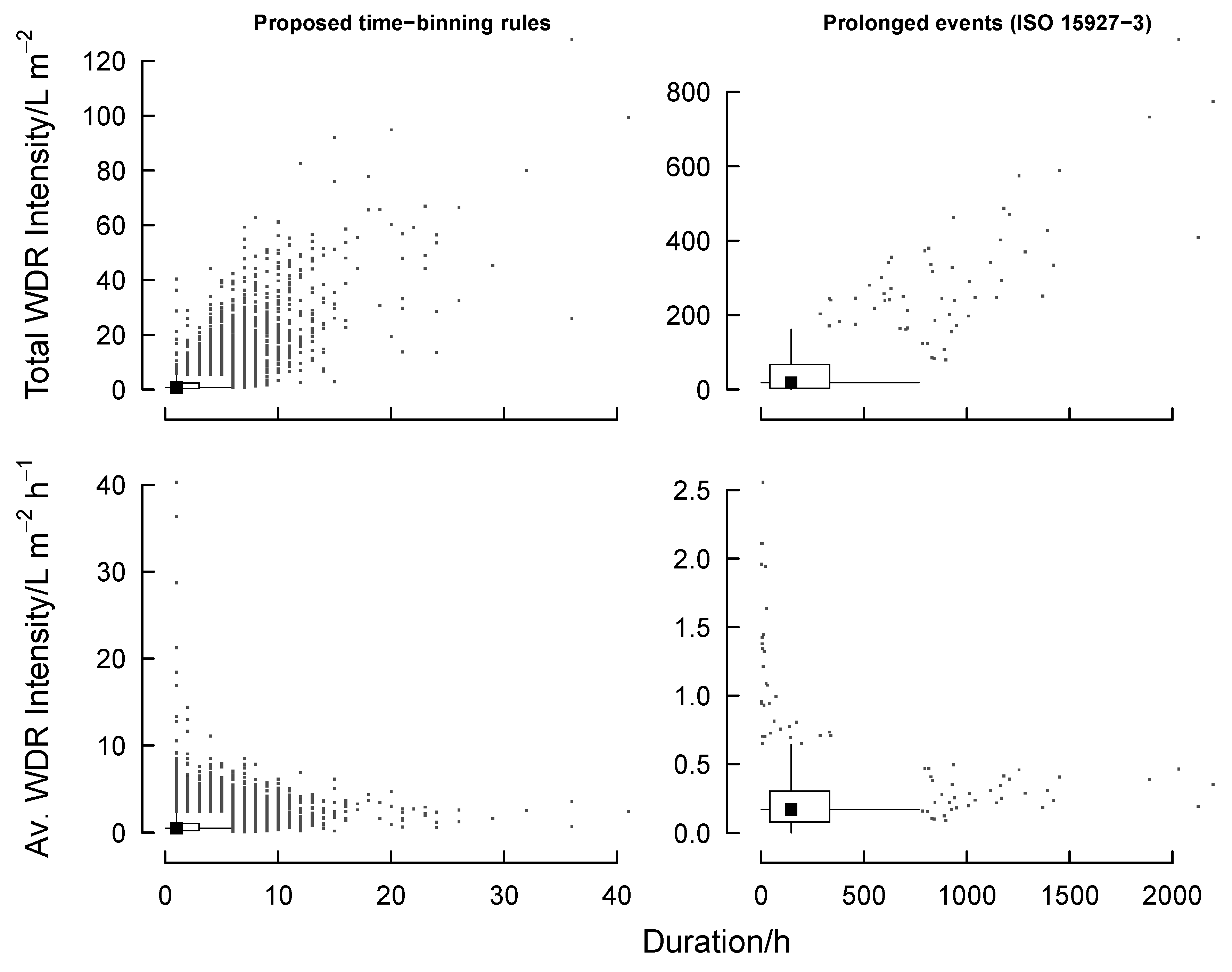

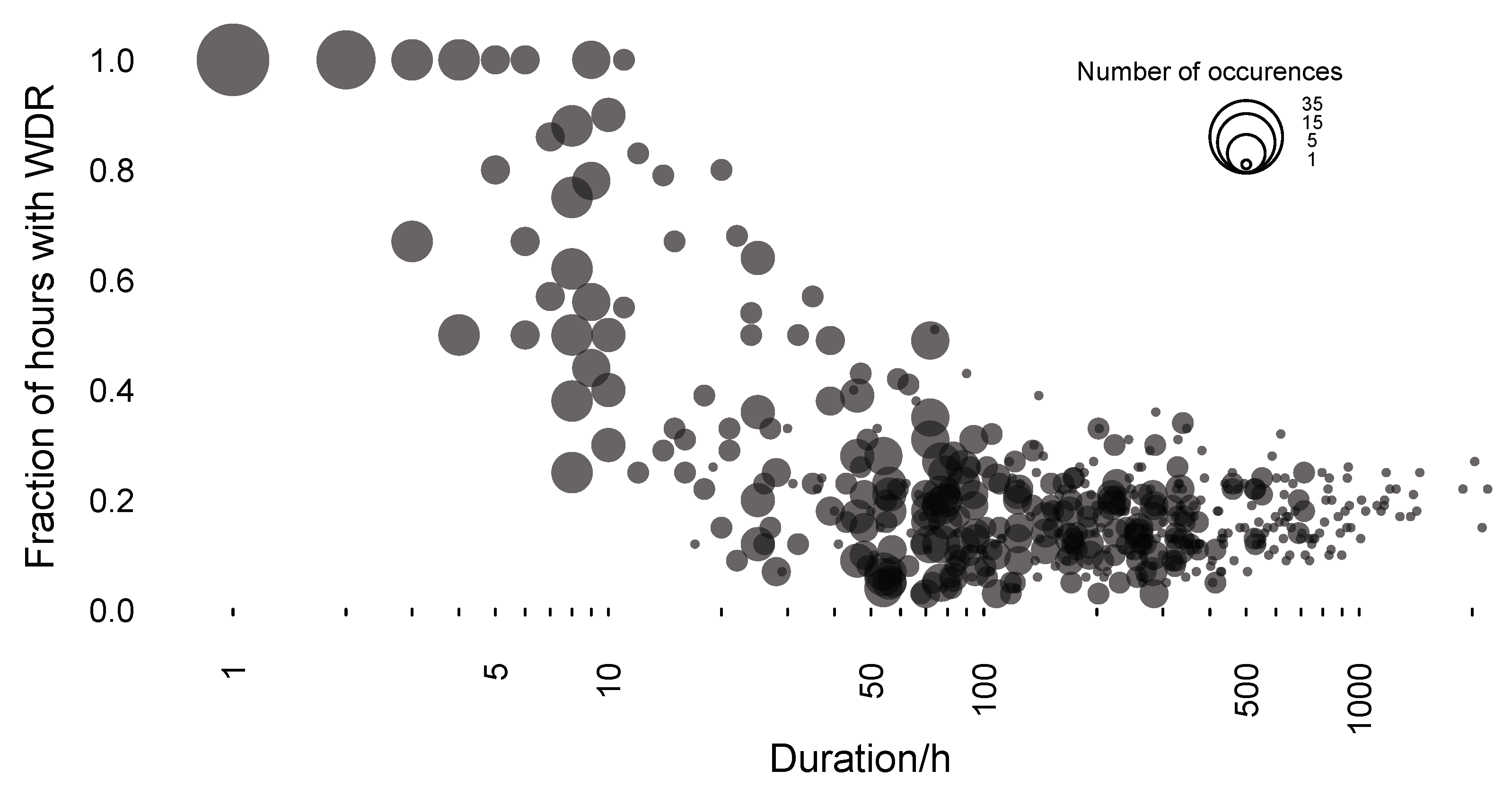
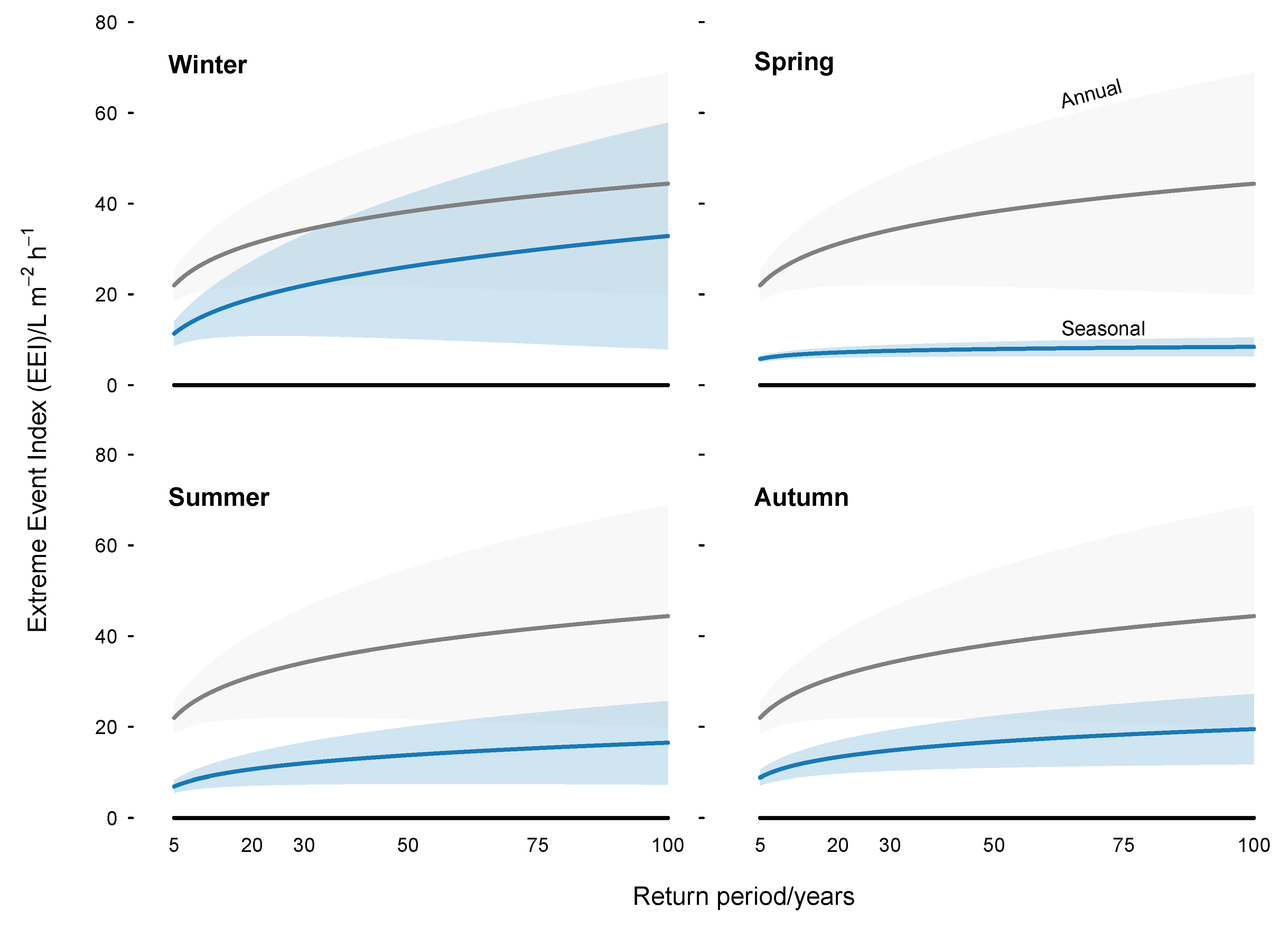
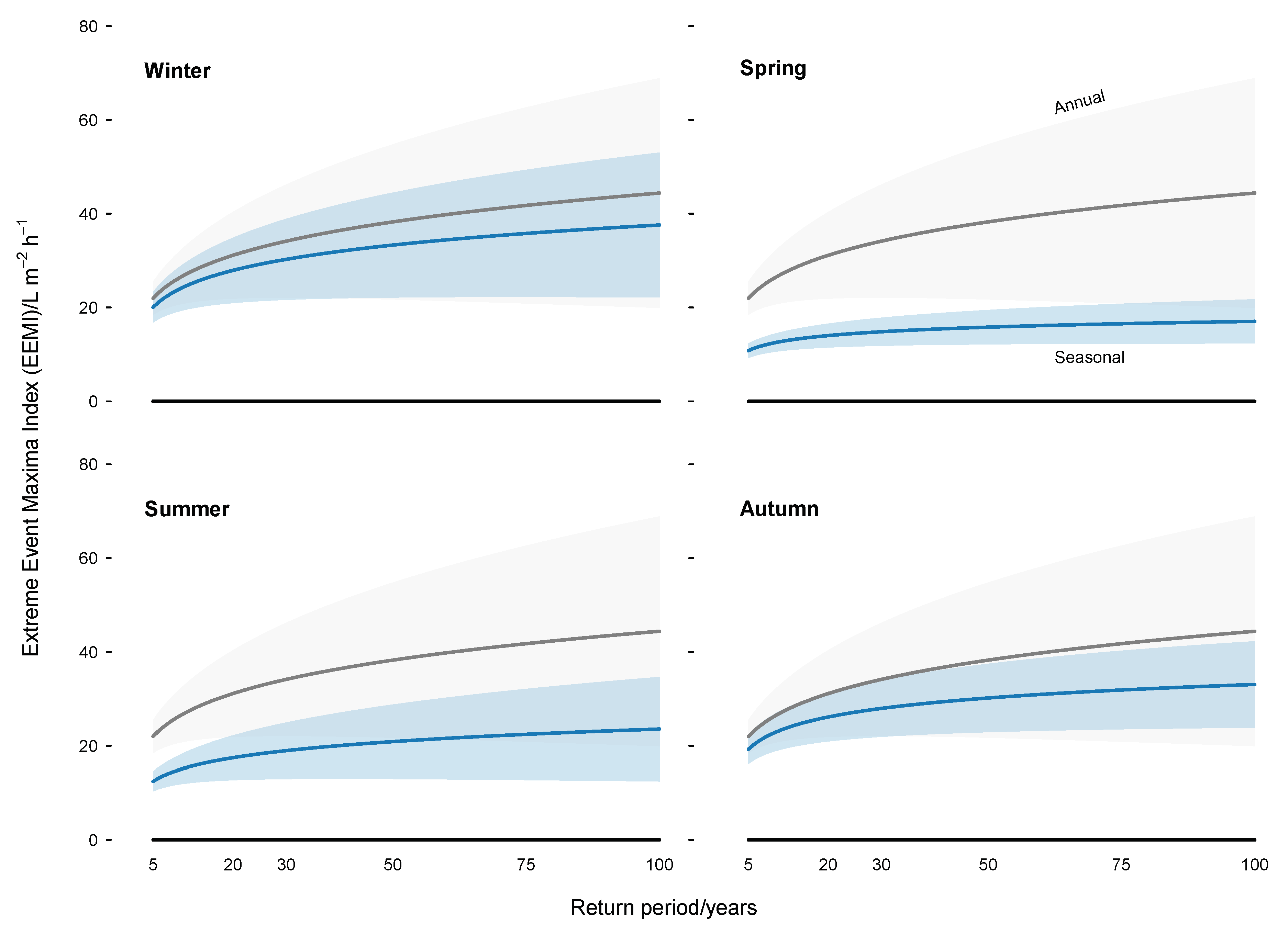
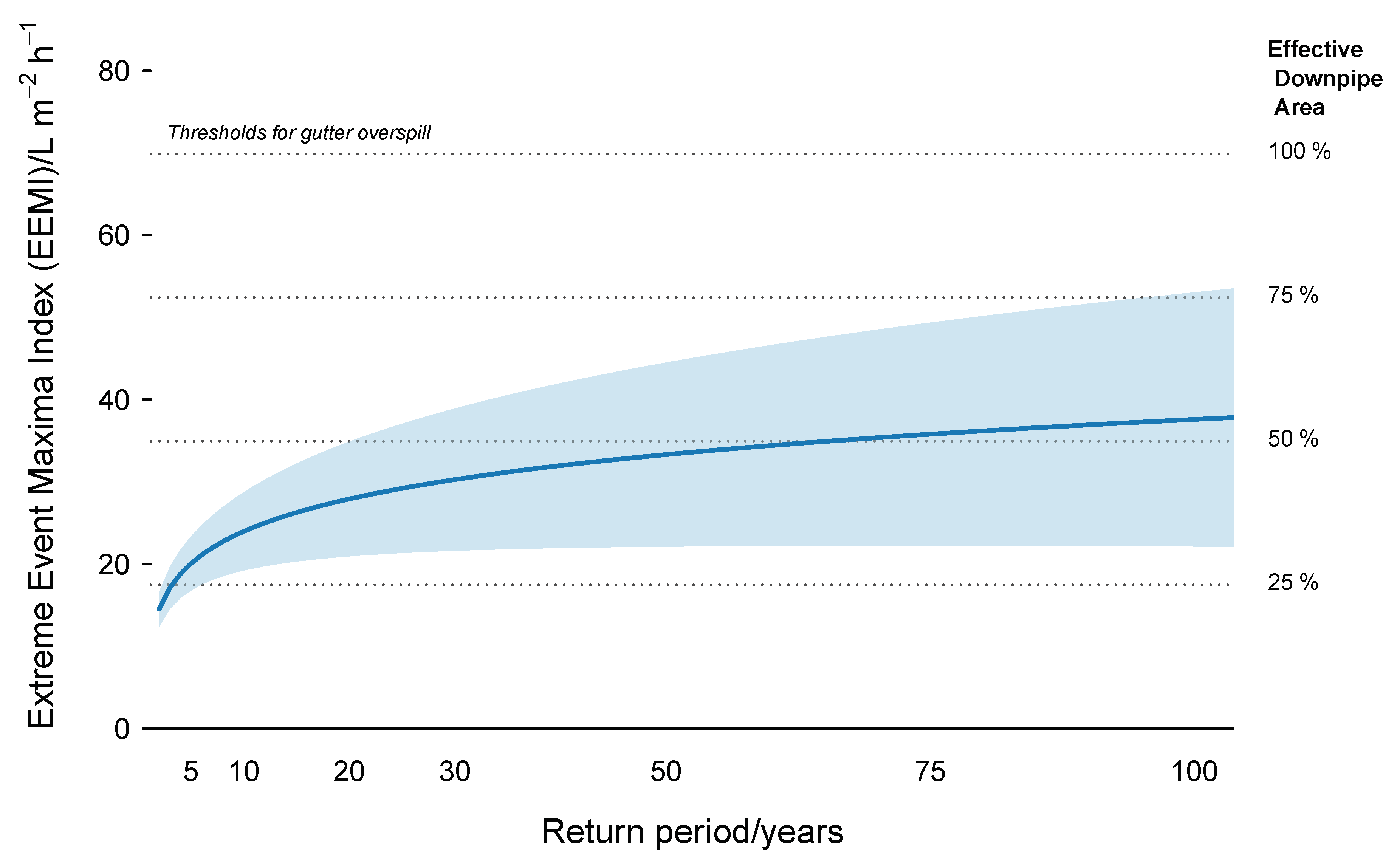
| Season | Proposed Time-Binning Rules | ISO15927-3 (Prolonged Exposure) |
|---|---|---|
| Winter (DJF) | 113 | 4 |
| Spring (MAM) | 73 | 5 |
| Summer (JJA) | 71 | 5 |
| Autumn (SON) | 96 | 4 |
| Total | 353 | 18 |
| Season | Extreme Event Index (EEI) | Extreme Event Maxima Index (EEMI) |
|---|---|---|
| Winter (DJJ) | 0.90 | 0.97 |
| Spring (MAM) | 0.98 | 0.99 |
| Summer (JJA) | 0.95 | 0.96 |
| Autumn (SON) | 0.91 | 0.99 |
| Annual | 0.89 | 0.93 |
| Parameter | Source | Value |
|---|---|---|
| Width of roof, = length of gutter, | informal observation | 5 m |
| Length of roof (eave to crest), | informal observation | 5 m |
| Area of roof (eave to crest), | Calculated | 25 m2 |
| Depth of gutter, | BS EN 8530:2010 [32] | 68.8 mm |
| Surface area of gutter, | Calculated | 0.344 m2 |
| Radius of downpipe, | BS EN 8530:2010 [32] | 0.0602 m |
| effective gutter area coefficient, f | - | 1, unless otherwise stated |
| downpipe coefficient, | with strainer | 0.5 |
| downpipe head, h | BS EN 12056–3:2000 [30] | mm |
| Rate of wind-driven rain, | measured climate data, ISO 15927–3:2009 [3] | dependent on return period, L h−1 |
© 2020 by the authors. Licensee MDPI, Basel, Switzerland. This article is an open access article distributed under the terms and conditions of the Creative Commons Attribution (CC BY) license (http://creativecommons.org/licenses/by/4.0/).
Share and Cite
Orr, S.A.; Cassar, M. Exposure Indices of Extreme Wind-Driven Rain Events for Built Heritage. Atmosphere 2020, 11, 163. https://doi.org/10.3390/atmos11020163
Orr SA, Cassar M. Exposure Indices of Extreme Wind-Driven Rain Events for Built Heritage. Atmosphere. 2020; 11(2):163. https://doi.org/10.3390/atmos11020163
Chicago/Turabian StyleOrr, Scott Allan, and May Cassar. 2020. "Exposure Indices of Extreme Wind-Driven Rain Events for Built Heritage" Atmosphere 11, no. 2: 163. https://doi.org/10.3390/atmos11020163





